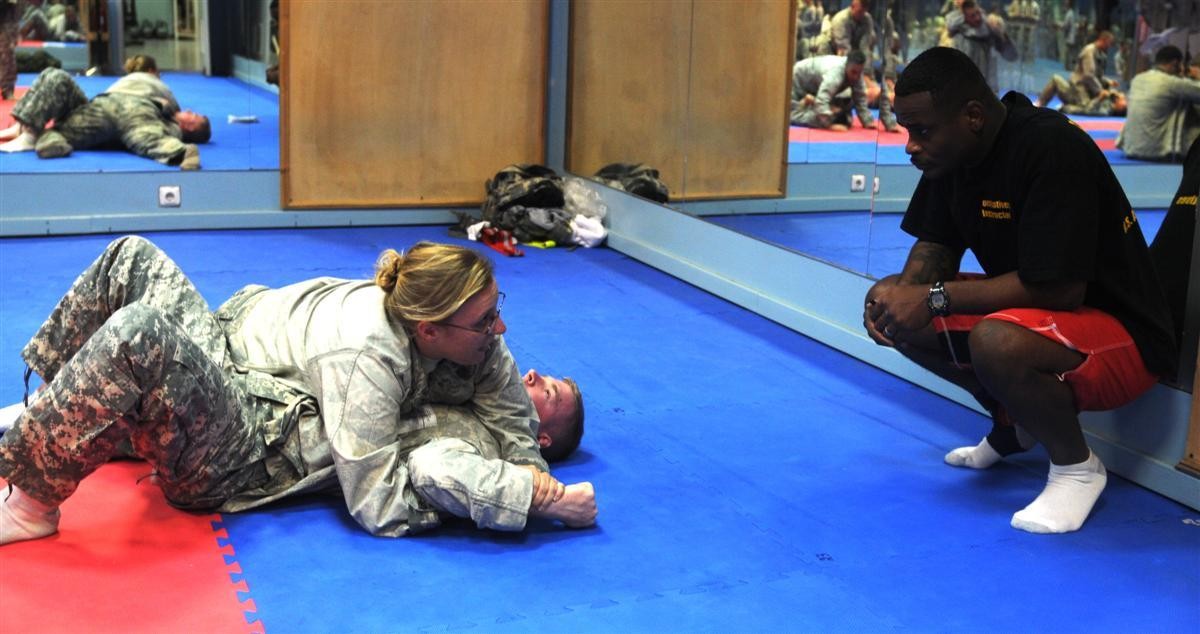JOINT BASE BALAD, Iraq - Service members on Joint Base Balad, Iraq, may soon be able to learn attack skills ranging from punching to placing opponents into submition.
Level two combatives classes, which are tentatively scheduled to begin in December at JBB at the East Gym, teach combatants intermediate attacking and defensive techniques, said Spc. Nigel Davis, noncommissioned officer in charge of the combatives program, with the 80th Ordnance Battalion.
Davis, a Brooklyn, N.Y., native, said the goal of the training in level one and two combatives is not to learn to fight, but teach service members to protect themselves and their battle buddies.
"This is not a school where we train fighters," said Davis.
Level one combatives classes have been at JBB for roughly a year - the November schedule for the Army combatives level one training certification classes was released Oct. 21 and will consist of three, one week classes that start Nov. 9.
Level two classes build on the skills learned in level one, teaching more intermediate defense and attack positions, said Davis.
"Level two gives more options on how to get out of situations and how to remain calm when put in stressful situations under close combat," he said.
Davis said level two also teaches officiating in a mixed martial arts match.
"Anyone who is level two certified can also be a puncher in the level one combatives class, and is allowed to be an assistant instructor," he said.
Level one is a 40-hour course, completed in a five-day period and the level two course is 80 hours, or two weeks, said Davis.
"We also understand that some personnel are not able to train the full five days, so some people can do half days," he said. "If possible we try to accommodate the participants around their schedules and try to be as flexible as possible."
Davis said the training consists of a basic format of ground-fighting techniques and stand-up fighting.
"We've also changed the outlook on mentally training the Soldiers as well," he said. "The students watch videos of live professional bouts and see how level one techniques are being used and standardized in their matches."
Standardized physical training does not properly prepare Soldiers for combatives training, said Davis.
Spc. Eric S. Borror, an ammunitions specialist with the 80th Ord. Bn. and a primary instructor for the JBB combatives program, said the PT workout they have created is gauntlet-style cardio training.
"We PT two of the five days of the course for about an hour and a half," said Borror. "The training consists of a lot of variations of cardio exercises, working upper body muscle groups and your core."
Davis said learning combatives helps prepare Soldiers for combat.
"Having this knowledge could help in a close combat situation," he said. "Think about the possibility of what would happen if there was a weapons malfunction. These classes prepare you for that type of situation."
The class does not focus only on fighting techniques, however.
"Level one is set up as a crawl, walk, run phase," said Davis. "We go through everything step by step, and the students have lots of time to review their techniques before being tested on the last day of class."
To graduate, the students must perform their techniques and teach them back to the instructor. They must also develop a thorough knowledge of the history of Army combatives, said Davis.
The final test is participation in, and completion of, the clinch drill, he said.
"The clinch drill exercise consists of four, one-minute rounds and (combatants) will have to achieve one of three clinch moves on the puncher," said Davis. "It's developed to have the Soldiers think while being attacked."
Pfc. Jaime J. Velez, a light wheeled mechanic for the 514th Maintenance Company out of Fort Drum, N.Y., said the only experience he had in combatives before taking the course was what he received in basic training. Velez, a Jayuya, Puerto Rico, native and the lightweight winner of the 80th Ord. Bn. combatives tournament last month, said the class has helped him.
"I've learned the proper mechanics and how to execute moves properly, as well as the history behind it," he said. "It is a great experience. We have great instructors and we've learned a lot this week."
According to the Fort Benning Web site on combatives classes, a level three or four certified instructor needs to validate the class in order for any service member to be certified as a level two combatant.
Davis, who is level three certified, said the level two combatives class is only tentatively scheduled for December due to mission time constraints.
Chief Warrant Officer 2 Richard Mantooth, who is level four certified, just arrived at JBB and will be able to validate the level two classes, said Davis.
Davis said Mantooth's missions take priority over combatives for the time being, but the level two classes will begin once he is settled in.
Borror, a Milford, Ill. native, said he really enjoys teaching the classes.
"It's not only a great self-confidence builder for the students, but also it is self-satisfying knowing that I'm teaching a skill set that Soldiers will incorporate on the battlefield," he said.




Social Sharing